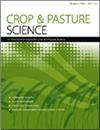Strawberry clover (Trifolium fragiferum): current status and future role in Australian agriculture
IF 1.9
4区 农林科学
Q2 AGRICULTURE, MULTIDISCIPLINARY
引用次数: 1
Abstract
ABSTRACT Strawberry clover (Trifolium fragiferum L.) is periodically raised as an alternative perennial pasture legume for temperate regions of Australia. Its tolerance of waterlogging is widely known, yet its ability to persist through periods of soil moisture deficit is often understated. Other desirable characteristics include its stoloniferous growth habit and tolerance of mildly saline conditions. Only four strawberry clover cultivars have been registered in Australia, and the most popular, cv. Palestine, is a direct introduction, released in 1938 and first certified in 1951. Furthermore, strawberry clover’s distribution has largely been confined to niche environments, particularly waterlogged and saline areas. This paper reviews the taxonomy and breeding system, morphology, distribution and ecology, and subsequent transfer of strawberry clover to Australia. It reviews and maps the suitability of strawberry clover for perennial pasture systems in the medium–-high rainfall and irrigated temperate zones of Australia, with reference to future climates. The paper also highlights the breeding focus, commercialisation and marketing required to supersede cv. Palestine and lists the germplasm available in the Australian Pastures Genebank, with origins. We conclude that, although strawberry clover is unlikely to become a dominant perennial pasture legume species in Australia, it could be used in a wider range of environments than just those affected by salinity and/or waterlogging stress.草莓三叶草(Trifolium fragiferum):在澳大利亚农业中的现状和未来作用
摘要草莓三叶草(Trifolium fragiferum L.)是澳大利亚温带地区的一种替代多年生牧草。它对内涝的耐受性是众所周知的,但它在土壤水分不足时期持续存在的能力往往被低估。其他可取的特征包括其匍匐茎生长习惯和对轻度盐碱条件的耐受性。只有四个草莓三叶草品种在澳大利亚注册,最受欢迎的品种巴勒斯坦是直接引进的,于1938年发布,1951年首次获得认证。此外,草莓三叶草的分布在很大程度上局限于生态位环境,特别是积水和盐碱地区。本文综述了草莓三叶草的分类和育种系统、形态、分布和生态学,以及随后转移到澳大利亚的情况。它审查并绘制了草莓三叶草在澳大利亚中高降雨量和灌溉温带多年生牧场系统中的适用性,并参考了未来的气候。该论文还强调了取代巴勒斯坦品种所需的育种重点、商业化和营销,并列出了澳大利亚牧场基因库中的可用种质及其来源。我们得出的结论是,尽管草莓三叶草不太可能成为澳大利亚主要的多年生牧场豆类物种,但它可以在更广泛的环境中使用,而不仅仅是受盐度和/或内涝胁迫影响的环境。
本文章由计算机程序翻译,如有差异,请以英文原文为准。
求助全文
约1分钟内获得全文
求助全文
来源期刊

Crop & Pasture Science
AGRICULTURE, MULTIDISCIPLINARY-
CiteScore
4.20
自引率
15.80%
发文量
111
审稿时长
3 months
期刊介绍:
Crop and Pasture Science (formerly known as Australian Journal of Agricultural Research) is an international journal publishing outcomes of strategic research in crop and pasture sciences and the sustainability of farming systems. The primary focus is broad-scale cereals, grain legumes, oilseeds and pastures. Articles are encouraged that advance understanding in plant-based agricultural systems through the use of well-defined and original aims designed to test a hypothesis, innovative and rigorous experimental design, and strong interpretation. The journal embraces experimental approaches from molecular level to whole systems, and the research must present novel findings and progress the science of agriculture.
Crop and Pasture Science is read by agricultural scientists and plant biologists, industry, administrators, policy-makers, and others with an interest in the challenges and opportunities facing world agricultural production.
Crop and Pasture Science is published with the endorsement of the Commonwealth Scientific and Industrial Research Organisation (CSIRO) and the Australian Academy of Science.
 求助内容:
求助内容: 应助结果提醒方式:
应助结果提醒方式:


